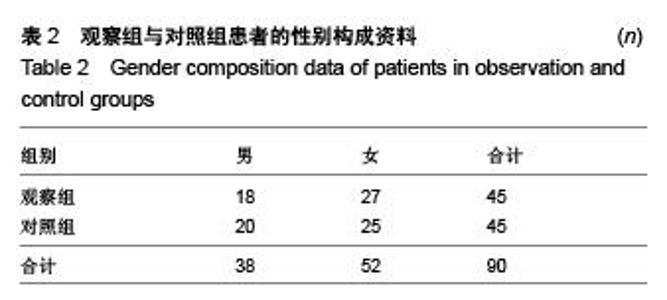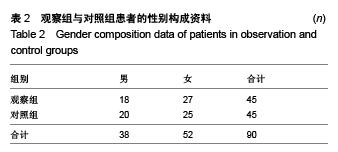Chinese Journal of Tissue Engineering Research ›› 2015, Vol. 19 ›› Issue (53): 8537-8542.doi: 10.3969/j.issn.2095-4344.2015.53.002
Previous Articles Next Articles
The establishment of allogeneic blood transfusion prediction model and precise detection after total knee arthroplasty
- Department of Orthopaedics, Baodi Clinical College of Tianjin Medical University, Tianjin 301800, China
-
Received:2015-10-31Online:2015-12-24Published:2015-12-24 -
Contact:Fang Guang-wen, Master, Associate chief physician, Department of Orthopaedics, Baodi Clinical College of Tianjin Medical University, Tianjin 301800, China -
About author:Zhou Zhi-guo, Master, Associate chief physician, Department of Orthopaedics, Baodi Clinical College of Tianjin Medical University, Tianjin 301800, China
CLC Number:
Cite this article
Zhou Zhi-guo, Fang Guang-wen, Zhang Ying-jian, Lv Ting-zhuo, Shang Fu-qing, Wang Shu-ping. The establishment of allogeneic blood transfusion prediction model and precise detection after total knee arthroplasty[J]. Chinese Journal of Tissue Engineering Research, 2015, 19(53): 8537-8542.
share this article
| [1] Pavone V, Boettner F, Fickert S, et al. Total condylar knee arthroplasty: a long-term followup. Clin Orthop Relat Res. 2001;(388):18-25.[2] Sextro GS, Berry DJ, Rand JA. Total knee arthroplsty using cruciate-retaining kinematic condylar prosthesis.Clin Orthop Relat Res. 2001;(388):33-40.[3] Buechel FF Sr, Buechel FF Jr, Pappas MJ, et al. Twenty-year evaluation of meniscal bearing and rotating platform knee replacements. Clin Orthop Relat Res. 2001;(388):41-50.[4] Mylod Jr AG, France MP, Muser DE, et al. Perioperative blood loss associated with total knee arthroplasty. Acomparison of procedures performed with and without cementing. J Bone Joint Surg.1990;72:1010-1012.[5] Klika AK, Small TJ, Saleh A, et al. Primary Total Knee Arthroplasty Allogenic Transfusion Trends, Length of Stay, and Complications: Nationwide Inpatient Sample 2000-2009. J Arthroplasty.2014;29:2070-2077.[6] Maslovitz S, Barkai G, Lessing JB, et al. Improved accuracy of postpartum blood loss estimation as assessed by simulation. Acta Obstet Gynecol Scand.2008; 87:929-934.[7] Shaw A, Lewis RB. Methods of measuring blood loss during surgery. J Med Eng Technol.1981;5:196-197.[8] Tebruegge M, Misra I, Pantazidou A, et al. Estimating blood loss: comparative study of the accuracy of parents and health care professionals. Pediatrics. 2009; 124:e729-736.[9] Sehat KR, Evans RL, Newman JH. Hidden blood loss following hip and knee arthroplasty.Correct management of blood loss should take hidden loss into account. J Bone Joint Surg. 2004;86:561-565.[10] Klika AK, Small TJ, Saleh A, et al. Primary Total Knee Arthroplasty Allogenic Transfusion Trends, Length of Stay, and Complications: Nationwide Inpatient Sample 2000-2009. J Arthroplasty. 2014;29(11):2070-2077.[11] Mylod AG Jr, France MP, Muser DE, et al. Perioperative blood loss associated with total knee arthroplasty. A comparison of procedures performed with and without cementing. J Bone Joint Surg Am.1990;72(7):1010-1012.[12] Maslovitz S, Barkai G, Lessing JB, et al. Improved accuracy of postpartum blood loss estimation as assessed by simulation. Acta Obstet Gynecol Scand. 2008;87(9):929-934. [13] Tebruegge M, Misra I, Pantazidou A, et al. Estimating blood loss: comparative study of the accuracy of parents and health care professionals. Pediatrics. 2009;124(4): e729-736.[14] Sehat KR, Evans RL, Newman JH. Hidden blood loss following hip and knee arthroplasty. Correct management of blood loss should take hidden loss into account. J Bone Joint Surg Br. 2004;86(4):561-565.[15] Ponnusamy KE, Kim TJ, Khanuja HS.Perioperative Blood Transfusions in Orthopaedic Surgery.J Bone Joint Surg Am. 2014;96(21):1836-1844.[16] Park JH, Rasouli MR, Mortazavi SM, et al. Predictors of perioperative blood loss in total joint arthroplasty. J Bone Joint Surg Am.2013;95(19):1777-1783. [17] Rosencher N, Kerkkamp HE, Macheras G, et al. Orthopedic Surgery Transfusion Hemoglobin European Overview (OSTHEO) study: blood management in elective knee and hip arthroplasty in Europe. Transfusion.2003;43(4):459-469.[18] Xu Q, Yang Y, Shi P, et al. Repeated doses of intravenous tranexamic acid are effective and safe at reducing perioperative blood loss in total knee arthroplasty. Biosci Trends. 2014;8(3): 169-175.[19] Patel JN, Spanyer JM, Smith LS, et al. Comparison of intravenous versus topical tranexamic acid in total knee arthroplasty: a prospective randomized study. J Arthroplasty. 2014;29(8):1528-1531. [20] Di Francesco A, Flamini S, Fiori F, et al. Hemostatic matrix effects on blood loss after total knee arthroplasty: A randomized controlled trial. Indian J Orthop. 2013;47(5):474-481.[21] Aggarwal AK, Shashikanth VS, Marwaha N. Platelet-rich plasma prevents blood loss and pain and enhances early functional outcome after total knee arthroplasty: a prospective randomised controlled study. Int Orthop.2014; 38(2):387-395.[22] 马金辉,孙伟,高福强,等.关节腔注射氨甲环酸单侧全膝关节置换者的失血量及肢体周径变化:随机对照[J].中国组织工程研究, 2014,18(35):5577-5582.[23] Torres-Claramunt R, Hinarejos P, Pérez-Prieto D, et al. Sealing of the intramedullar femoral canal in a TKA does not reduce postoperative blood loss: a randomized prospective study. Knee.2014;21(4):853-857.[24] Moráis S, Ortega-Andreu M, Rodríguez-Merchán EC, et al. Blood transfusion after primary total knee arthroplasty can be significantly minimised through a multimodal blood-loss prevention approach. Int Orthop.2014;38(2): 347-354. [25] 李文,德李虎,吕厚山.改良的后关节囊止血方式对全膝关节置换术围手术期失血量的影响[J].中华外科杂志,2011,49(7): 652-653.[26] Panni AS, Cerciello S, Vasso M, et al. Knee flexion after total knee arthroplasty reduces blood loss. Knee Surg Sports Traumatol Arthrosc.2014;22(8):1859-1864.[27] Napier RJ, Bennett D, McConway J, et al. The influence of immediate knee flexion on blood loss and other parameters following total knee replacement. Bone Joint J. 2014;96-B(2): 201-209. [28] Levine BR, Haughom B, Strong B, et al. Blood management strategies for total knee arthroplasty. J Am Acad Orthop Surg. 2014;22(6):361-371.[29] Kapadia BH, Banerjee S, Issa K, et al. Preoperative blood management strategies for total knee arthroplasty. J Knee Surg. 2013;26(6):373-377. [30] Frisch NB, Wessell NM, Charters MA, et al. Predictors and complications of blood transfusion in total hip and knee arthroplasty. J Arthroplasty.2014;29(9Suppl):189-192.[31] Noticewala MS, Nyce JD, Wang W, et al. Predicting need for allogeneic transfusion after total knee arthroplasty.J Arthroplasty. 2012;27:961-967.[32] Krebs VE. Blood conservation in total joint arthroplasty. 2000 Current Concept of Joint Replacement.2000, Orlando, USA.[33] 王青,陶桂年,吕征,等.术后引流血回输在全膝关节置换术后的应用[J].中华骨科杂志,1998,11(11):702-703.[34] 冯国璋,戴号,解骏,等.自体血回输在类风湿性关节炎全膝关节置换术后的临床应用[J].国外医学:骨科分册,2004,25(5):316-318.[35] Thomassen BJ, den Hollander PH, Kaptijn HH, et al. Autologous wound drains have no effect on allogeneic blood transfusions in primary total hip and knee replacement: a three-arm randomised trial. Bone Joint J.2014;96-B:765-771.[36] Schneider MM, Kendoff D, Oloughlin PF, et al. Effectiveness of autologous transfusion system in primary total hip and knee arthroplasty.Technol Health Care.2014;22:123-128.[37] Bjerke-Kroll BT, Sculco PK, McLawhorn AS, et al. The increased total cost associated with post-operative drains in total hip and knee arthroplasty. J Arthroplasty.2014;29: 895-899.[38] Dramis A, Plewes J.Autologous blood transfusion after primary unilateral total knee replacement surgery. Acta Orthop Belg. 2006; 72: 15-17.[39] Strümper D, Weber EW, Gielen-Wijffels S, et al. Clinical efficacy of postoperative autologous transfusion of filtered shed blood in hip and knee arthroplasty.Transfusion. 2004;44:1567-1571.[40] Horstmann W, Kuipers B, Ohanis D, et al. Autologous re-transfusions drain compared with no drain in total knee arthroplasty: a randomised controlled trial. Blood Transfus. 2014;12Suppl1:s176-181.[41] Haien Z, Yong J, Baoan M, et al. Post-operative auto-transfusion in total hip or knee arthroplasty: a meta-analysis of randomized controlled trials. PLoS One. 2013;8:e55073.[42] Apostolopoulos A. The effectiveness of reinfosion after total knee replacement a prospective randomized controlled study. Int Orthop.2007;317:303-308.[43] Mirza SB, Campion J, Dixon JH, et al.Efficacy and economies of postoperative blood salvage in patients undergoing elective total hip replacement. Ann R Coll Surg Engl.2007; 89:777-784. |
| [1] | Chen Ziyang, Pu Rui, Deng Shuang, Yuan Lingyan. Regulatory effect of exosomes on exercise-mediated insulin resistance diseases [J]. Chinese Journal of Tissue Engineering Research, 2021, 25(25): 4089-4094. |
| [2] | Chen Yang, Huang Denggao, Gao Yuanhui, Wang Shunlan, Cao Hui, Zheng Linlin, He Haowei, Luo Siqin, Xiao Jingchuan, Zhang Yingai, Zhang Shufang. Low-intensity pulsed ultrasound promotes the proliferation and adhesion of human adipose-derived mesenchymal stem cells [J]. Chinese Journal of Tissue Engineering Research, 2021, 25(25): 3949-3955. |
| [3] | Yang Junhui, Luo Jinli, Yuan Xiaoping. Effects of human growth hormone on proliferation and osteogenic differentiation of human periodontal ligament stem cells [J]. Chinese Journal of Tissue Engineering Research, 2021, 25(25): 3956-3961. |
| [4] | Sun Jianwei, Yang Xinming, Zhang Ying. Effect of montelukast combined with bone marrow mesenchymal stem cell transplantation on spinal cord injury in rat models [J]. Chinese Journal of Tissue Engineering Research, 2021, 25(25): 3962-3969. |
| [5] | Gao Shan, Huang Dongjing, Hong Haiman, Jia Jingqiao, Meng Fei. Comparison on the curative effect of human placenta-derived mesenchymal stem cells and induced islet-like cells in gestational diabetes mellitus rats [J]. Chinese Journal of Tissue Engineering Research, 2021, 25(25): 3981-3987. |
| [6] | Hao Xiaona, Zhang Yingjie, Li Yuyun, Xu Tao. Bone marrow mesenchymal stem cells overexpressing prolyl oligopeptidase on the repair of liver fibrosis in rat models [J]. Chinese Journal of Tissue Engineering Research, 2021, 25(25): 3988-3993. |
| [7] | Liu Jianyou, Jia Zhongwei, Niu Jiawei, Cao Xinjie, Zhang Dong, Wei Jie. A new method for measuring the anteversion angle of the femoral neck by constructing the three-dimensional digital model of the femur [J]. Chinese Journal of Tissue Engineering Research, 2021, 25(24): 3779-3783. |
| [8] | Meng Lingjie, Qian Hui, Sheng Xiaolei, Lu Jianfeng, Huang Jianping, Qi Liangang, Liu Zongbao. Application of three-dimensional printing technology combined with bone cement in minimally invasive treatment of the collapsed Sanders III type of calcaneal fractures [J]. Chinese Journal of Tissue Engineering Research, 2021, 25(24): 3784-3789. |
| [9] | Qian Xuankun, Huang Hefei, Wu Chengcong, Liu Keting, Ou Hua, Zhang Jinpeng, Ren Jing, Wan Jianshan. Computer-assisted navigation combined with minimally invasive transforaminal lumbar interbody fusion for lumbar spondylolisthesis [J]. Chinese Journal of Tissue Engineering Research, 2021, 25(24): 3790-3795. |
| [10] | Hu Jing, Xiang Yang, Ye Chuan, Han Ziji. Three-dimensional printing assisted screw placement and freehand pedicle screw fixation in the treatment of thoracolumbar fractures: 1-year follow-up [J]. Chinese Journal of Tissue Engineering Research, 2021, 25(24): 3804-3809. |
| [11] | Shu Qihang, Liao Yijia, Xue Jingbo, Yan Yiguo, Wang Cheng. Three-dimensional finite element analysis of a new three-dimensional printed porous fusion cage for cervical vertebra [J]. Chinese Journal of Tissue Engineering Research, 2021, 25(24): 3810-3815. |
| [12] | Wang Yihan, Li Yang, Zhang Ling, Zhang Rui, Xu Ruida, Han Xiaofeng, Cheng Guangqi, Wang Weil. Application of three-dimensional visualization technology for digital orthopedics in the reduction and fixation of intertrochanteric fracture [J]. Chinese Journal of Tissue Engineering Research, 2021, 25(24): 3816-3820. |
| [13] | Sun Maji, Wang Qiuan, Zhang Xingchen, Guo Chong, Yuan Feng, Guo Kaijin. Development and biomechanical analysis of a new anterior cervical pedicle screw fixation system [J]. Chinese Journal of Tissue Engineering Research, 2021, 25(24): 3821-3825. |
| [14] | Lin Wang, Wang Yingying, Guo Weizhong, Yuan Cuihua, Xu Shenggui, Zhang Shenshen, Lin Chengshou. Adopting expanded lateral approach to enhance the mechanical stability and knee function for treating posterolateral column fracture of tibial plateau [J]. Chinese Journal of Tissue Engineering Research, 2021, 25(24): 3826-3827. |
| [15] | Zhu Yun, Chen Yu, Qiu Hao, Liu Dun, Jin Guorong, Chen Shimou, Weng Zheng. Finite element analysis for treatment of osteoporotic femoral fracture with far cortical locking screw [J]. Chinese Journal of Tissue Engineering Research, 2021, 25(24): 3832-3837. |
| Viewed | ||||||
|
Full text |
|
|||||
|
Abstract |
|
|||||



